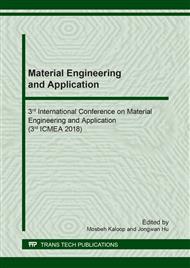p.31
p.37
p.45
p.51
p.59
p.64
p.69
p.76
p.82
The Efficiency of Phosphorus Removal of Synthetic Wastewater through Struvite Crystallization in an Aerated Fluidized Bed Reactor
Abstract:
The high organic material contained in wastewater released into the environment asresults of various sources of human activities, such as phosphorus, can cause eutrophication. Thestruvite crystallization in an aerated fluidized bed reactor is one of the methods which able toimprove the efficiency of phosphorus removal. In this study, a mixture of synthetic wastewaters andthe MgCl2 solution was treated in a fluidized bed reactor equipped with aeration to produce thestruvite which can be utilized as a slow release fertilizer. Subsequently, the effect of aeration atdifference influent flow rate was investigated to correlate with the changing of phosphorusconcentration in the reactor effluent. The experiments were conducted for 240 minutes with thevariation of aeration are 0.5 L/min to 1.5 L/min; variation of influent flow rate of syntheticwastewater is 150 ml/min to 350 ml/min, with a constant influent flow rate of MgCl2 solution is 50ml/min. These solutions were maintained at the condition of pH 9. The results showed that theoptimal efficiency of phosphor removal which accounted for 82.5% occurred when the aeration rateof 1.5 L/min in the influent flow rate of 150 ml/min. From these findings, it is revealed that theefficiency of P removal in wastewater is obtained by a crystallization process which utilizing anaerated fluidized bed reactor and by increasing the aeration rate and the reactants contact time.
Info:
Periodical:
Pages:
59-63
Citation:
Online since:
November 2018
Price:
Сopyright:
© 2018 Trans Tech Publications Ltd. All Rights Reserved
Share:
Citation:


